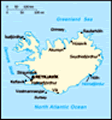Advertisement
Published: November 19th 2009
10:15 PM
There was no big rush for the shower this morning like there was in Vik. There are five people staying in Hvoll, including us, meaning we are actually outnumbered by bathrooms. This meant that this morning I was able to shower and shave without the pressure of thinking that I need to move quickly just in case somebody had to miss a bus or something just because I wanted to be clean. Not that anybody would be catching a bus from Hvoll, as it was a good 5km or so to walk to the main road, after which they would probably need to hitch a lift if they didn’t want to spend the rest of the day walking to the nearest bus stop.
The plan for today was to drive out to Skaftafell national park, around 35km further down the road, and spend most of the day there. Skaftafell is pretty big, taking in mountains, waterfalls and a significant part of Vatnajökull, the biggest Icecap outside of the poles. The part we were heading for, though, was an area of hilly, green countryside slotted in between the beginning of the glacier and the sandur, or glacial
desert that runs out to the sea. On the way there, Route 1 cuts across the edge of the Sandur, and as we drove along this flat, sandy landscape, we were reminded, perhaps surprisingly, of the power of water. Out of the sand rose something twisted in shape, red in some places, grey in others. Intrigued, we pulled in at the lay-by next to it which also, conveniently, had an English language placard telling us exactly what we were looking at. What looked like a weird modern art installation in the middle of the sandur was actually the remains of a bridge that had crossed this part of the country when Route 1 had been located a bit further north, until 1996. This was the year of Iceland’s last jökulhlaup, which translates as ‘glacial burst’. A big volcano underneath the ice erupted, and the resulting meltdown sent millions of litres of water flowing across the area, ripping the bridge and the rest of Route 1 out of the ground and dumping it downstream when it got bored. Both jökulhlaup and sandur are, although Icelandic words, used to describe such phenomena throughout the world. The sandur has been pretty much created

 Twisted Metal
Twisted Metal
Used to be a bridgeby these jökulhlaup over the years; once the water has flowed out to the sea all that is left is black sand and ash, although the winds in the area are gradually expanding the size of the desert.
Once we had arrived at Skaftafell, we spent the first couple of hours gradually climbing some of the hills and passing the various waterfalls on the way. Eventually we made it to a good viewing point where we could clearly view the glacier, the sandur and the mountains in each direction. After this, the icy plant life started to give way to steeper, rockier mountains and eventually snow, so we decided now was a good time to start heading back down, particularly as Lyndsey’s camera decided it couldn’t fit any more pictures on it at this point.
We went back down a slightly different way, past an old brick farmhouse with a turf roof, some of which was open for us to look around, so we popped into the old cow shed, outside of which I was able to electrocute myself on the perimeter fence. Twice.
Once back down at the bottom, we ate our pre-prepared
packed lunch dinner in the car, then took a brief look around the visitor centre which was due to close not long after, before heading in the opposite direction to the way we had gone in the morning towards the bottom of the glacier. The route round had a warning sign advising us that there was a significant danger of rocks falling on our heads and taking our brains out, but we ignored the sign and followed the path round, taking a slight diversion where some particularly large boulders had obliterated the official way round. The edge of the glacier was largely covered in grit and dirt, and so close up gave a slightly dull, grey colour as oppose to the brilliant white behind it, but it was impressive nonetheless.
By the time we left Skaftafell it was around 4.30, so, not wanting to just go back to the hostel yet, we carried on along Route 1 to see what was further down the road. Not far down, we found a petrol station with a small cafe and a shop, so we stopped here for a hot chocolate and some cans of Viking beer. We carried on down
the road for 30km or so, stopping a few times along the way to have a look at the views of the glacier as we went around. The wind was really picking up in this area, to the point where it blew the car door into Lyndsey’s head, knocking some sense into her and leaving a proud, egg-sized lump on her head.
Eventually, the road started to look icy again, so I decided that this was a sign for us to turn back, past the few farm buildings we had seen along the way, past Skaftafell, past the twisted metal bridge, and eventually back to Hvoll just as the light had faded.
Advertisement
Tot: 0.049s; Tpl: 0.012s; cc: 7; qc: 25; dbt: 0.0284s; 1; m:domysql w:travelblog (10.17.0.13); sld: 1;
; mem: 1.1mb












